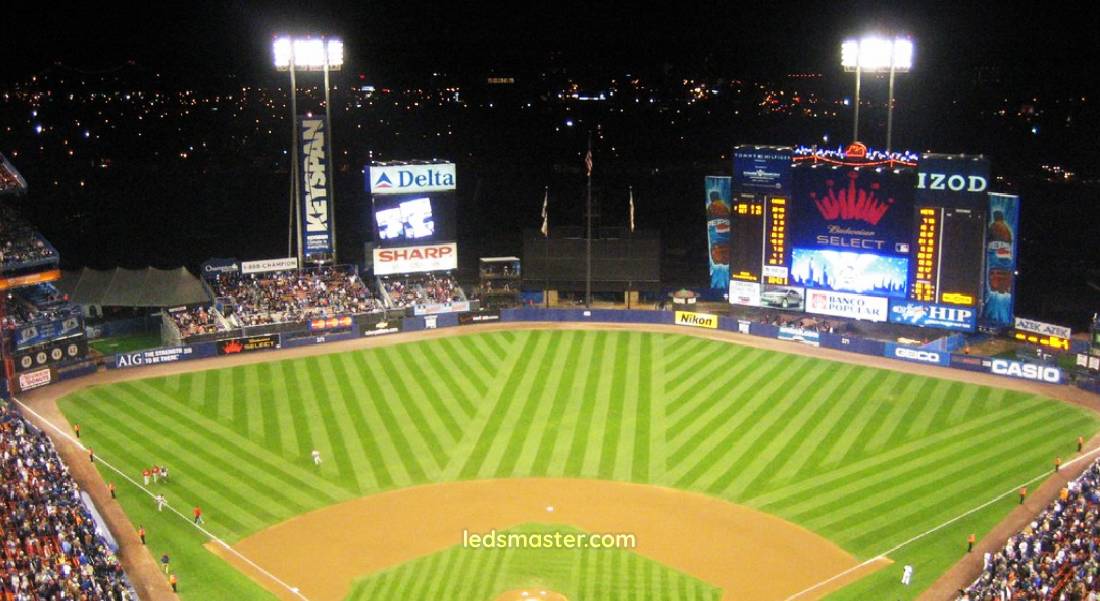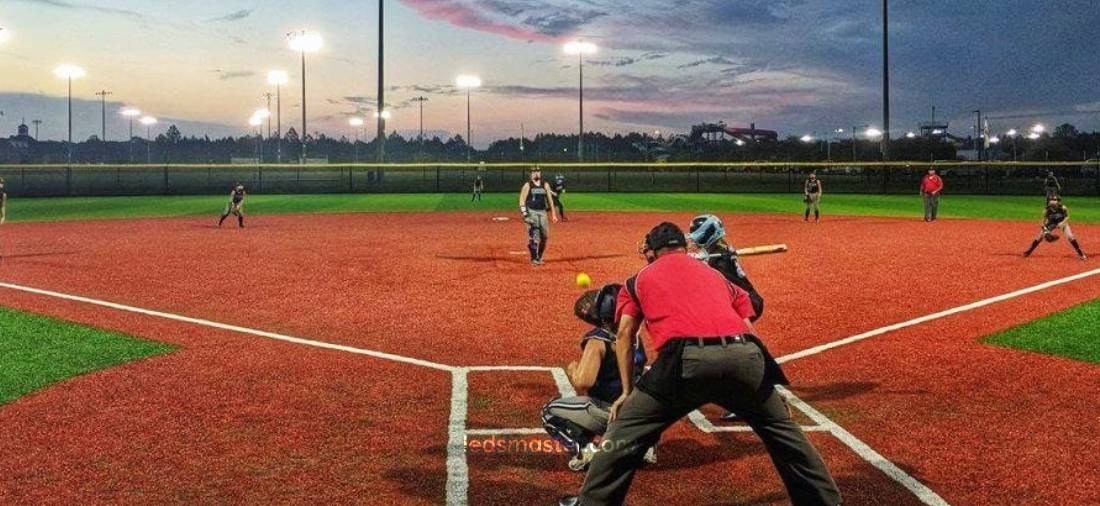In baseball, adequate lighting reduces shadows that can obstruct visibility and affect player performance. Understanding the dynamics of light beam angles, the influence of shadows on athletes, and methods to minimize shadows can create an optimal playing environment.
Table of Contents
ToggleThe Impact of Light Beam Angles on Shadows
Light Beam Direction and Uniformity
The way light is directed onto a baseball field—specifically, the angle at which light beams hit the surface—has a profound influence on how the field is illuminated. This angle dictates how evenly the light is spread across the field, which is critical for visibility. When light beams are improperly angled, they create uneven brightness levels across the field. Certain areas may be brightly lit, while others are left in darkness or partial shadows. These variations can make it difficult for players to see clearly, as shadows distort their visual perception of the game.
Effect of Improper Angling on Visibility
For example, if light poles are positioned inappropriately or the light is not angled to cover all parts of the field, shadowed areas may appear, particularly where players stand or where the ball may land. This can lead to a situation where, at any given moment, some players might struggle to see the ball clearly because shadows obscure its location or make it harder to judge its trajectory. This affects the game on both an individual level (for each player) and a collective level (for the overall flow of the game).
How Light Pole Height and Placement Impact Lighting
The height of the light poles and their placement on the field are just as influential in the formation of shadows. When light poles are too low, they cast shorter, more intense beams, which tend to create long, harsh shadows. These shadows may stretch across the field and fall on key areas where players are trying to track the ball, like the outfield or around the bases. If these shadows are cast across the pitcher’s mound or the batter’s box, they can significantly impair a player’s ability to judge a pitch’s speed or trajectory. On the other hand, when light poles are too high or their beams are directed too steeply, the lighting can become overly intense in certain areas of the field, making other sections dim or creating an uneven light spread.
Achieving the Right Balance in Lighting
Achieving an ideal balance involves understanding how the intensity of light and its direction can complement the size and layout of the field. Proper beam spread ensures that the lighting is consistent without leaving any dark or overly bright patches. When lighting is adjusted to cover the entire field evenly, players can focus better, have clearer depth perception, and reduce the occurrence of misjudgments. A well-lit field allows players to read the ball and other elements more effectively, improving their ability to respond during a game.
The Importance of Depth Perception
In baseball, depth perception is crucial for players in judging the ball’s movement and location. Reducing shadows ensures that players are not hindered by visual distortions. By minimizing shadows, athletes are better equipped to judge the speed of a pitch, the distance of a fly ball, or the direction of a ground ball, enhancing their overall performance on the field.
Methods to Reduce Shadows on Baseball Fields

Optimizing Lighting Design
One of the first steps in reducing shadows on a baseball field is optimizing the lighting design. The strategic placement and angling of light fixtures are fundamental to creating an even distribution of light across the field. By positioning light poles at appropriate intervals and directing their beams at specific zones, a balanced illumination is achieved, minimizing overlapping shadows. This approach ensures that every part of the field is consistently lit, preventing areas of darkness or overly bright spots from disrupting gameplay.
The process of designing an effective lighting layout can be enhanced by the use of computer-aided design (CAD) software. CAD allows designers to simulate various lighting configurations and test different beam angles, helping them identify the most effective placement for light poles. Factors such as pole height, beam spread, and the dimensions of the field must be carefully considered to ensure optimal coverage. Through these simulations, the best lighting setup can be determined, significantly reducing shadows and improving visibility for players and spectators.
Upgrading to Advanced Lighting Technologies
Advancing lighting technology plays a pivotal role in reducing shadows. Traditional lighting systems such as metal halide or halogen lights often provide uneven light coverage, contributing to areas of darkness and glare. Modern lighting technologies, particularly LED systems, offer several advantages in this regard. LED lights are capable of producing more focused and adjustable beams compared to older lighting systems, allowing for precise control over light distribution and intensity.
LEDs are highly versatile and provide more uniform light output, minimizing glare and shadows. Unlike traditional lighting, which can create harsh, uneven lighting zones, LEDs ensure that the field is consistently illuminated, creating an optimal environment for athletes. In addition to their fixed capabilities, LED lighting systems can also integrate dynamic control systems, which can adjust the lighting in real-time based on changing conditions. For example, the lighting intensity may automatically adjust in response to the movement of players or the stage of the game, further reducing shadows and improving the playing experience.
Increasing the Number of Light Fixtures
Another method to minimize shadows on a baseball field is to increase the number of light fixtures. Adding additional lights in areas that are more prone to shadows can help balance the overall illumination. This solution addresses the problem by filling in gaps where the light from existing fixtures may not reach. Smaller floodlights or supplementary lights can be strategically placed to fill in these areas without causing excessive brightness.
However, adding more light fixtures should be done with caution. Excessive lighting can create new problems, such as glare, which can strain players’ eyes and affect their performance. The key is to find a balance between sufficient light coverage and avoiding overly bright areas that could lead to visual discomfort. Proper planning ensures that additional fixtures improve visibility without overwhelming the players or the audience.

Implementing Reflective Surfaces
Reflective surfaces placed around the baseball field can also help in reducing shadows. These surfaces bounce light back into areas that would otherwise remain dim or shadowed. Materials such as polished metal, reflective coatings, or specialized barriers can redirect light more efficiently, improving light distribution without requiring the installation of additional fixtures.
Reflective surfaces are particularly useful for areas that are difficult to illuminate directly, such as the corners of the field or spots that are overshadowed by players or other objects. By incorporating reflective materials into the design, the field can achieve better overall illumination and reduce the formation of dark spots that hinder visibility. This method is an efficient and cost-effective way to complement lighting fixtures and enhance the overall lighting system.
Regular Maintenance and Adjustments
Once an optimal lighting design is in place, ongoing maintenance is crucial to ensure that the system continues to perform effectively. Over time, dirt, dust, and other debris can accumulate on light fixtures, diminishing their light output and creating areas of reduced visibility. Regular cleaning and inspection of the lighting equipment ensure that these issues do not compromise the lighting quality.
In addition to cleaning, periodic adjustments to the angles and positioning of the lights may be necessary as field conditions change. Weather events, changes in field layout, or adjustments in player positions can all impact how light is distributed across the field. Operators should regularly evaluate the lighting setup and make adjustments to improve coverage and minimize shadows. This process allows for continuous enhancement of the lighting system, ensuring that it remains effective throughout the season.
Conducting Lighting Audits and Feedback
Conducting thorough lighting audits is another important step in identifying and addressing shadow-related problems on the field. A lighting audit involves measuring the brightness levels at various points across the field and identifying areas that receive insufficient lighting. These audits provide valuable data that can inform adjustments to the lighting setup, helping to optimize coverage and eliminate shadowed zones.
Player and coach feedback is also a valuable tool in identifying lighting issues. Since players spend the most time on the field, their insights into where shadows interfere with their performance can help lighting designers make targeted improvements. By combining technical audits with real-world feedback, operators can make informed decisions on how to adjust the lighting to suit the specific needs of the players and the game.
Employing Advanced Control Systems
Advancements in lighting control systems provide innovative solutions for managing light distribution and reducing shadows. Smart lighting systems equipped with sensors and automation can detect shadowed areas and automatically adjust the brightness or beam angles in real-time. These systems can ensure that shadows are minimized without requiring manual intervention, providing a seamless experience for players and spectators.
Smart lighting can also enhance energy efficiency, as the system can adjust the lighting based on specific needs during different game conditions. For example, if a game transitions from daylight to nighttime, the system can gradually increase the lighting levels while maintaining uniformity across the field. These automated systems help ensure consistent and optimal lighting while reducing the need for constant monitoring and manual adjustments.
By integrating advanced control technologies, teams can ensure that their lighting systems provide the best possible playing conditions, offering both practical and performance-related benefits. Whether through real-time adjustments or automated monitoring, these systems enhance the overall quality of the game while also improving the energy efficiency of the lighting setup.
Conclusion
Minimizing shadows on a baseball field requires a thoughtful combination of design, technology, and maintenance. From the initial planning stages of light placement to the ongoing refinement of setups, every effort contributes to creating an environment where players can perform at their best. By addressing the interplay between light beam angles, shadow effects, and practical solutions, baseball fields can provide an optimal space for both athletes and spectators.

